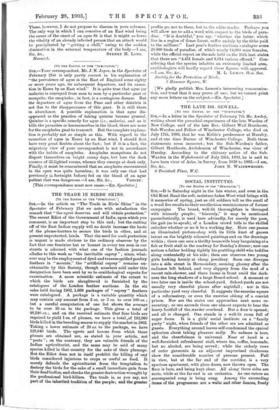THE TRADE IN BIRDS' SKINS.
[To THE EDITOR OF THE "SPECTATOR."] Sza,—In the article on " The Trade in Birds' Skins " in the Spectator. of February 21st we note with satisfaction the remark that "the egret deserves and will obtain protection." The recent Edict of the Government of India, upon which you comment, is an important step to this end; but the cutting off of the. East Indian supply will no doubt increase the haste of the plume-hunters to secure the birds in other, and at present unprotected, lands. That the need for such.protection is urgent is made obvious to the ordinary observer by the fact that one feminine hat or bonnet in every ten seen in our streets is adorned with what one of the fashion journals alludes to this week as " the inevitable osprey " ; since, what- ever may be the employment of dyed and transmogrified poultry feathers in "mounts," the "artificial osprey " remains un- obtainable by this Society, though numbers sold under this designation have been sent by us to ornithological experts for examination. A more scientific estimate of the extent to which the birds are slaughtered is furnished by the catalogues of the London feather auctions. In the six sales held during 1902, 1,608 packages of " osprey " feathers were catalogued. A package is a variable quantity which may contain any, amount from 2 oz. or 3 oz. to over 100 oz. ; but a careful computation of one list shows the average to be over 30 oz. to the package. This gives a total of 48,240 oz.; and on the received estimate that four birds are required to yield 1 oz. of plumes, we have a total.of 192,960 birds killed in the breeding season to supply the market in 1902. Taking a lower estimate of 20 oz. to the package, we have 128,640 birds. The egrets and herons from which these plumes are obtained are, as stated in your article, not " pests "; on the contrary, they are valuable friends of the Indian agriculturist, and the same may be said of many species killed in that country for the sake of their plumage. But the Edict does not in itself prohibit the killing of any birds considered injurious to crops or useful as food. It merely defends the agriculturist from the temptation to destroy the birds for the sake of a small immediate gain from their dead bodies, and checks the greater destruction wrought by the professional bird-killers. The trade is, as you say, not part of the inherited tradition of the people; and the greater
profits go, not to them, but to the white trader. Perhaps you will allow me to add a word with respect to the birds of para- dise. "It is doubtful," you say, " whether the latter, which live in a region of dense forest, suffer unduly by the tithe paid to the milliner." Last year's feather auctions catalogue some 20,000 birds of paradise, of which nearly 14,000 were females, while the official report on the sale held on the 10th inst: states that there are "4,451 female and 8,814 various offered." Con- sidering that the species inhabits an extremely limited area, orniihologists will hardly regard these figures with approval.
—I am, Sir, &c., M. L. LEMON, Hon. Sec. Society for the Protection of Birds, 3 Hanover Square, W.
[We gladly publish Mrs. Lemon's interesting communica- tion, and trust that it may prove of use ; but we cannot print any more letters on the subject.—En. Spectator.] .










































 Previous page
Previous page